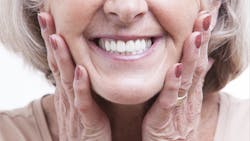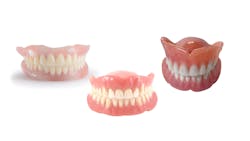Fall in love with dentures and watch your practice flourish
In the current economy, dental practices have been presented with challenges as well as unique opportunities. It is imperative that we get out of our comfort zones, streamline business practices, and seek innovative ways to reach new patients, reduce costs, and increase profits while maintaining business excellence.1,2
Let’s get right to the point. Dentures are not very sexy but can be a lucrative practice-builder. There are approximately 40 million people in the US with no teeth4 and that number increases by 2–3 million per year. Here, we'll give an overview of three different denture methods along with their pros and cons. All have their place in your practice, whether solo, group, or dental service organization (DSO). We will only discuss complete dentures.
Related reading:
- Economic management of the ill-fitting denture: The hard-soft double reline
- How to stop hating dentures
- Patients hate flippers and so should you
The need for dentures is increasing. These patients have the potential to fill empty chairtime with profitable procedures. We’ll compare three different approaches to denture fabrication: conventional multi-visit dentures, digital dentures, and the Larell One Step Denture. We will discuss the major differences between them and how each will impact workflow, overhead, patient satisfaction, practice growth, and profit (figure 1).
Conventional dentures
Traditionally fabricated dentures have basically been done the same way for over 100 years. They are completed in about five visits. The multiple visits include: initial impression for a custom tray, final impressions with border molding, wax rims, wax try-in, and then processing and finishing of the finished denture. The denture goes to the lab for many of these steps, and the entire procedure takes from four to six weeks.
Facebow transfers, Gothic arch tracings, articulators, and other devices are used for positioning, esthetics, and speech and functional considerations at these intermediate visits. Customization of the dentures for each patient is possible, in both shade, shape, and alignment of teeth to address a wide range of mouths. Post-delivery adjustments are often necessary, requiring three to four hours and at least four or five sets of personal protective equipment (PPE). Standard dental practice overhead of about 70% applies. Lab bills for complete dentures can be $400–800. The national average fee for a set of complete dentures as of 2020 was $3,400.1 There is no capital outlay for equipment, only disposable supplies for the steps in the dental office. Net profit would be around $290 per hour.
Digital dentures
Digital denture use is increasing, and there are two techniques most often used. The first technique results in a milled denture, made from a solid block of acrylic in a subtractive procedure, carving the denture out of a solid material (puck). The teeth and base are either milled as one piece, monolithic, or added post-milling. In the second technique, the denture is fabricated through an additive 3D printing process, in one piece or two, base and teeth separately.
Digital processing usually takes two or three patient visits. Scans are taken of the edentulous ridges, vestibules, palate, and other soft tissues. The data is entered into computer programs and the dentures are designed. Required equipment includes a scanner, software, and milling machine or 3D printer along with post-processing finishing of the teeth, gingiva, and colorations.
Post-processing by the dentist is needed and will depend on hardware, software, and the quality of the scans. Intraoral structures are dynamic, so it’s critical to capture the movement of the facial muscles, tongue, and lips accurately to minimize the need for revision.5 This can be an issue with digital dentures. Chairtime for the initial visit is typically about 1.5 hours. A facial scanner is sometimes used to help develop the esthetics. Delivery can be from 30 minutes to an hour if the procedure is completed in two visits. Often three visits are necessary for completion including final finishing and adjustment. At least two or three sets of PPE are used. Outside lab costs are comparable to conventional denture lab costs, $400–800 or higher. The cost to the patient is often higher than a conventional denture, but this may change in the future. With similar but slightly higher overhead (due to the need for the hardware, software and equipment maintenance) the net profit to the dentist will be about $400 per hour.
As with any new technology there is a learning curve. Advances are being made in digital dentures to increase quality and process usability. The digital dentures process results in an actual digital file which can be stored and used to produce a duplicate denture without rescanning the patient if the need arises.
The Larell One Step Denture
The Larell One Step Denture is an in-office technique used to fabricate a set of complete dentures in a single, approximately hour-long visit without the need for an outside lab. This patented denture method consists of a semi-custom thermoplastic polymethyl methacrylate (PMMA) acrylic denture base. The teeth are individually preset, and come in five sizes to fit virtually all patients. The teeth have a universal shape with tooth size matching the denture size. The cost to the dentist, per arch, is less than $200. You maintain total control over the process.
After choosing the correct size Larell base, the denture is heated in boiling water for 45 seconds. It then becomes malleable and is fit closely to a stone model of the arch. It is then tried into the mouth. The occlusal plane and vertical dimension of occlusion (VDO) are easily established in the mouth with an occlusal plane plate. A chairside hard reline is then done. With the mouth as the articulator, the denture is bordermolded for a perfect fit with pleasing esthetics (figure 2).A suggested fee to the patient for a set of upper and lower dentures is $1,500. With total material cost of less than $400 for both arches and total time of about one hour, the net profit is close to $1,000 per hour. Only one set of PPE is needed. Minimal adjustments are needed due to in-mouth fitting. The Larell denture is a custom comparable denture3 and meets American Dental Association (ADA) standards for longevity (five to seven years). The denture is also well-suited for immediate dentures and as a provisional for all-on-four type implant restorations, meaning it’s great for nursing home patients and others who need a denture on the spot.
Choose the best method for each individual patient
Overhead and expenses are climbing rapidly. Dentist incomes are declining.1 The average practice has 10%–15% empty chair time. It’s crucial to put more emphasis on finding new patients and being efficient and more profitable in every procedure. Most patients have less disposable income and many insist on faster treatment in fewer visits with lower fees.
In these uncertain times, it’s critical that we seek new patients and profitable approaches to treatment. Increasing the denture patient segment can help with many of these challenges. The trick is to tap into the denture market and find the method best suited for each individual patient.
At the end of the day, dentures allow us to send patients out into the world happy with beautiful smiles. What more could you hope for, as a dental professional?
Editor’s note: This article appeared in the August 2022 print edition of Dental Economics magazine. Dentists in North America are eligible for a complimentary print subscription. Sign up here.References
- US dental spending down in 2020. American Dental Association. Health Policy Institute. https://www.ada.org/-/media/project/ada-organization/ada/ada-org/files/resources/research/hpi/hpigraphic_1221_1.pdf
- Malcmacher L. Sustaining profitability during the pandemic. Dental Economics. April 20, 2021. https://www.dentaleconomics.com/14201625
- Comparison of conventional and Larell dentures in safety net clinics. Unpublished study. Virginia Healthcare Foundation. 2014.
- Facts & Figures. American College of Prosthodontics. https://www.gotoapro.org/facts-figures/
- Patzelt SB, Vonau S, Stampf S, Att W. Assessing the feasibility and accuracy of digitizing edentulous jaws. J Am Dent Assoc. 2013;144(8):914–920. doi:10.14219/jada.archive.2013.0209
About the Author

Lawrence Wallace, DDS
Lawrence Wallace, DDS, is a graduate of the University of Illinois College of Dentistry, and completed oral surgery training at Long Island Jewish Medical Center. Having practiced for 25 years, Dr. Wallace developed the Larell One Step Denture. A board-certified oral and maxillofacial surgeon, he lectures nationally and internationally on denture and dental implant topics and teaches the Larell Denture technique. Contact Dr. Wallace at [email protected] or (831) 659-9300.
Updated August 16, 2022

William Donigan, DDS, MPH
William Donigan, DDS, MPH, is chief dental officer at Kintegra Health in Gastonia, North Carolina. He uses the Larell method in all of his safety net clinics, and has brought Larell dentures to many countries on philanthropic missions. He is an expert advisor for D4 Practice Solutions with 40 years of clinical experience. Contact Dr. Donigan at [email protected] or (704) 772-4648.
Updated August 16, 2022


